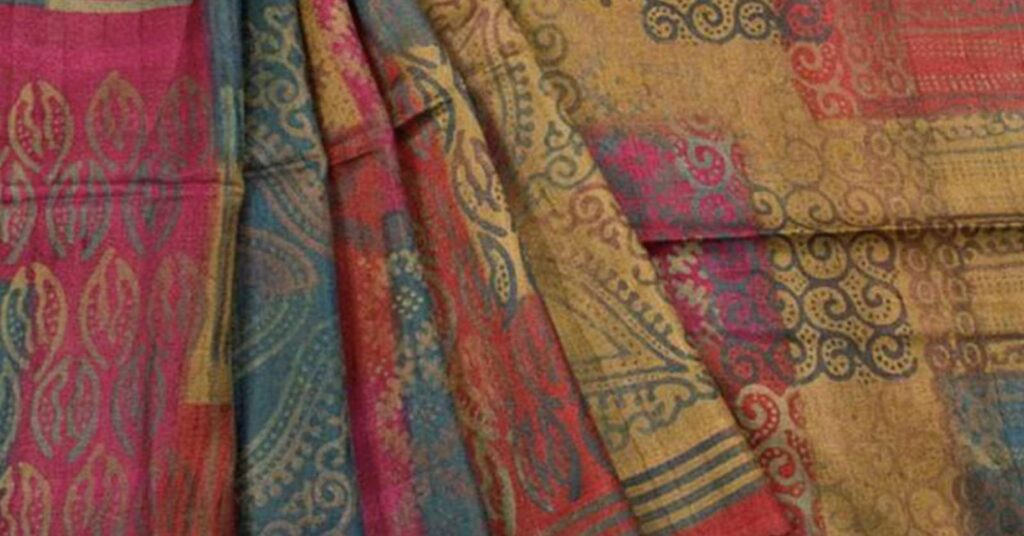Are you curious to know what is tussar silk? You have come to the right place as I am going to tell you everything about tussar silk in a very simple explanation. Without further discussion let’s begin to know what is tussar silk?
Silk has always held a special place in the world of fashion and textiles, celebrated for its luxurious feel, sheen, and versatility. Among the many types of silk, Tussar silk stands out as a unique and environmentally-friendly choice. Also known as “Tussah” or “Kosa” silk, this fabric has been cherished for centuries due to its rich texture and cultural significance. In this blog, we’ll dive deep into the world of Tussar silk, exploring its origins, characteristics, and how it’s produced.
What Is Tussar Silk?
Tussar silk, a type of wild silk, has a long history that dates back to ancient India. It is primarily produced in the eastern and northeastern regions of the country, including states like Bihar, Jharkhand, Odisha, and West Bengal. The silk is derived from several species of silkworms, the most notable being the Antheraea mylitta. These silkworms feed on the leaves of the Arjun and Asan trees, imparting a distinct texture and color to the silk.
Characteristics Of Tussar Silk
- Natural Beauty: Tussar silk is renowned for its earthy, natural appeal. Unlike the glossy finish of conventional silk, Tussar has a more matte appearance, which exudes elegance and understated charm. The fabric is often adorned with tiny, irregular slubs, creating a unique texture that adds character to any garment.
- Softness and Comfort: Tussar silk is soft to the touch and comfortable to wear. Its breathable nature makes it an excellent choice for clothing, especially during warm weather.
- Versatility: Tussar silk can be woven into various styles and patterns, making it suitable for both traditional and contemporary fashion. It is used to create sarees, kurtas, dresses, and accessories like stoles and scarves.
- Vibrant Colors: Tussar silk takes dye exceptionally well, resulting in rich, vibrant colors that stay true and bright over time. This makes it a favorite among textile artists and designers.
- Durability: Despite its delicate appearance, Tussar silk is surprisingly durable, thanks to the natural fibers and production process. Proper care can ensure your Tussar silk garments last for a long time.
The Making Of Tussar Silk
The production of Tussar silk involves several labor-intensive steps, all of which contribute to its unique qualities:
- Cocoon Harvesting: The process starts with the collection of silkworm cocoons, which are spun by the Antheraea mylitta silkworms.
- Boiling and Degumming: The collected cocoons are boiled to soften the sericin, a protein that binds the silk threads. This process also helps in unraveling the long silk fibers.
- Spinning: After degumming, the softened fibers are hand-spun into yarn. The irregularities in the yarn add to the charm of Tussar silk.
- Weaving: Tussar silk is woven using traditional handlooms, which allows weavers to create intricate patterns and designs.
- Dyeing and Printing: Once woven, the fabric can be dyed or printed with various designs, often inspired by nature and culture.
Let’s find some more interesting topics like these here askcorran.
The Sustainability Of Tussar Silk
Tussar silk is often considered more environmentally friendly than its mulberry silk counterpart. The silkworms thrive in the wild, which reduces the need for controlled environments and artificial feed. Additionally, the use of handlooms for weaving minimizes the carbon footprint associated with large-scale industrial production.
Conclusion
Tussar silk is more than just a fabric; it’s a cultural heritage, an embodiment of nature’s elegance, and a sustainable choice in the world of textiles. Its unique texture, softness, and versatility make it a prized possession for fashion enthusiasts and eco-conscious consumers alike. So, the next time you come across a Tussar silk garment, take a moment to appreciate the centuries of tradition, craftsmanship, and beauty that it represents.
FAQ
Is Tussar Silk Real Silk?
Tussar silk is pure silk that’s grown in forests. It has a few telltale characteristics, so here’s how you can check if you’re buying real tussar silk. The texture is rough and grainy to the touch. Real silk has a natural shine that reflects the light with a warm glow.
What Is Special About Tussar Silk?
Tussar silk is a type of wild silk, which is made from silkworms that feed on plants like asan and Arjun. It is famous and valued for its natural golden color. The main producers of tussar silk are Jharkhand and Bihar. Tussar silk is lightweight, has a luxurious touch, and feels like a charm.
What Is Difference Between Tussar Silk And Silk?
Tasar silk is slightly less lustrous and coarser. However, it is Tasar silk that beats Mulberry silk in strength, endurance, and versatility. Although Tasar silk is less lustrous than Mulberry silk, the Tasar silk price makes it more affordable. Artisans prefer it for its versatility.
How Do You Identify Tussar Silk?
Tussar silk is known for its distinctive texture, which is often described as being ‘rough’ or ‘crinkly. ‘ This is due to the fact that the fibers of tussar silk are shorter than those of other silks, such as mulberry silk. As a result, tussar silk fabrics are less smooth and have a more uneven surface.
I Have Covered All The Following Queries And Topics In The Above Article
What Is Tussar Silk Fabric
What Is Tussar Silk Saree
What Is Tussar Silk Made Of
What Is Tussar Ghicha Silk
How To Identify Tussar Silk
What Is Tussar Silk Used For
What Is Tussar Silk Sarees
What Is Tussar Silk Price
What Is Tussar Silk Fabric Used For
What Is Tussar Silk Made Of
Is Tussar Silk Good
Tussar Silk Worm
What Is Tussar Silk
Is tussar silk real silk






